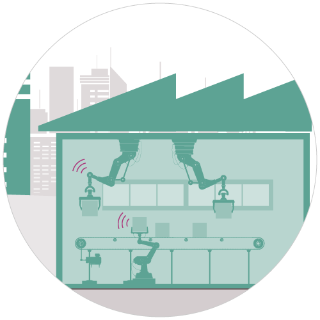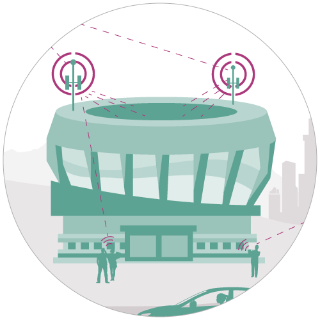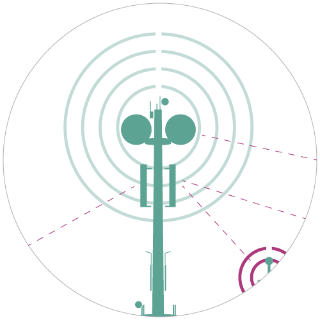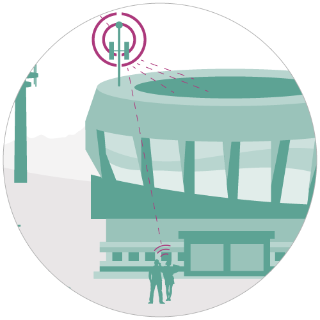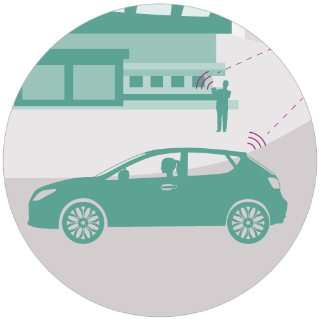
The next development stage of the mobile network is 5G. This new technology allows a significantly higher data capacity and extremely fast response times. This opens up completely new potential applications for a fully connected society.
The super-fast 5G mobile wireless standard forms the basis for the connected Gigabit society. In particular, it will stimulate applications that are especially demanding when it comes to exchanging data. In a smart city, for example, 5G can provide motorists with congestion and accident warnings as well as information on where to find a free parking space. Vehicles can communicate with one another or with the infrastructure – with fast and reliable data transmission acting as a driver for highly automated motoring. Even software updates with new functions for the car can be performed in seconds by means of a mobile radio interface.
Industry 4.0 is another example of an important 5G application. With its networked value creation and supply chains, widescale sensor monitoring of production systems and interacting robots, Industry 4.0 is reliant on effective communication.
Super-fast mobile communications will make the use of media more individual, flexible and versatile in future too. Take a concert or football match, for example, where several thousand people can access the mobile Internet at the same time. They can follow the event interactively in real time as well as from a variety of different perspectives in 4K/8K Super HD on the smartphone. 5G offers a data capacity that is 100 times greater than LTE and data transmission rates that are more than a thousand times faster. Thanks to barely perceptible latencies, the cellular standard allows a lightning-fast response in the network and uses less power in the process. These impressive performances are the result of four innovations.
What does 5G mean?
5G stands for “fifth generation,” the name of the next standard in mobile communication. This standard will replace the current LTE standard (4G). Earlier standards were UMTS (3G) and GSM (2G). 5G will offer greater bandwidths of up to 10 gigabits per second and extremely low response times. That enables a much faster transmission rate and meets growing communication requirements in an increasingly networked society. 5G will require considerably less power for data transmission: Compared to the previous standard, 5G needs only a thousandth of the power for each transmitted bit.

Overview: Smart connection with 5G

Pink highlights: small cell (beamforming) > 6 GHz
What advantages does 5G offer?
The mobile standard 5G will offer a transmission rate that is around 100 times faster than that of LTE with data rate of up to 10 gigabits per second. Even videos in 4K format can be loaded at lightning speed. Downloading the content of a DVD takes less than five seconds. Delays, such as are commonplace in video telephony, will be a thing of the past. Telemedicine applications will thus be possible, in which a surgeon carries out operations over the internet. At the same time, the new 5G network will permit greater bandwidths, thus allowing a large number of users to be supplied faster simultaneously and receive higher quality. That means 5G will be far more stable and reliable.


Simply explained: How 5G works
Millimeter waves

Smartphones and other electronic devices have to date used a very narrow frequency range of between 3 KHz and 3 GHz. Yet a rapidly growing number of mobile, connected devices and things are sharing this range – inevitably leading to ever slower data transmission speeds and increasing the susceptibility of the connection to failure. The solution is to use frequencies in a range below 6 GHz, but especially in the millimeter wave range with frequencies of between around 30 and 300 GHz, in which mobile devices are not yet transmitting data. Sufficient bandwidth is available here for the Internet of Things. Millimeter waves have one disadvantage however: they cannot penetrate stone house walls and can be absorbed by trees or heavy rain.
Small cell network

To avoid data transmission dead spots in the millimeter range, many small transmitting stations are located at close proximity to subscribers. They form a small cell network, which extends the existing cellular network. Expanding the network in this way allows closer proximity to users, yet at a low transmitting power level. Due to the smaller spacing of the stations, the cellular or IoT device can always find a good connection to the next station. Infineon supplies the maximum frequency components necessary to make this happen. Monolithic Microwave Integrated Circuits (MMIC) allow transmission of data at frequencies of up to 90 GHz – the market is currently focusing on frequencies of up to 40 GHz.
Massive MIMO

In a transmission system using MIMO technology (Multiple Input Multiple Output), the data stream is transmitted using multiple transmitting and receiving antennas. This improves the receive signal, extends the possible distance and increases data throughput in general. While LTE usually combines up to eight antenna elements at most, 5G requires significantly more power: Several hundred antennas are frequently used at a receiver-transmitter station in the case of millimeter waves. This optimized multiple antenna technology, or Massive MIMO as it is known, increases the capacity of the cellular network by a multiple. However Massive MIMO requires an additional technology in order to exploit the advantages of the millimeter waves: the signals can only be focused and transmitted reliably using beamforming, as it is known.
Beamforming

Signals are radiated uniformly in all directions using traditional antennas. If signals overlap with those from other transmitters, interference can arise to the significant detriment of the signal transmission. The Massive MIMO multiple antenna technology resolves this problem in combination with beamforming: by sending the same signal at staggered intervals using several antennas, the transmitter targets the approximate location of the client and aligns its transmission power accordingly – thus creating a signal beam or beamforming. This means that a beamforming transmitter can send individual signals to individual recipients in different directions. This increases the coverage, ensures a more stable connection as well as higher transmission rates and reduces unwelcome radio interference.
Data security thanks to semiconductor solutions
Increased connectivity means that the need for data security is also greater. Smart homes, connected cars and Industry 4.0 require protection against unauthorized access as well as secure data and processes. Thanks to its innovative semiconductor-based security solutions, Infineon is also protecting the future 5G cellular structure from the rising number of security threats.
When can we expect 5G to be rolled out?
There are enormous technical and financial challenges to be faced when it comes to developing a new cellular infrastructure. While initial applications exist at present, they are still more so at the pilot stage. For example, South Korea demonstrated initial 5G millimeter wave applications at the Winter Olympics in 2018. The first four radio cells throughout Europe went into operation in Berlin in 2017, which transmit live and in a real-life environment over 5G. In the U.S., Verizon announced that it plans to launch pilot projects with 28 GHz millimeter waves in 2018 still. AT&T intends to start tests with 5G transmissions in the 39 GHz range in 2019 in several cities in the U.S. It will be some years yet though before there will be extensive availability. By 2025, for example, Europe should have a well-developed 5G network in place in major cities, according to targets set by the EU Council of Ministers.

Use Cases: 5G in everyday life
After work in the smart city

The meeting with her sales colleagues lasted until late in the evening. Isabel Grainger is driving home through the city at night, thinking all the time: “Thank goodness there are no more traffic jams at this time of day like during the rush hour.” The journey from the north of the city to her suburban home in the south can easily take more than an hour in the early evening.
The drawback in finishing work late, however, is that there’s hardly anywhere to park in the streets. But Isabel’s not worried about that. The area she lives in is part of a pilot project. The streetlights are fitted with radar sensors and radio frequency identification (RFID) chips. They detect whether there’s an empty parking space nearby and pass this information to a central server via the mobile network.
A corresponding app is installed in Isabel’s car. It shows her on the navigation system where there are places to park under which streetlights. In fact, Isabel doesn’t need to look for long. She can park just around 150 yards from her home. “That makes things so much easier,” thinks Isabel as she parks. “It saves time and fuel. And you don’t get on the neighbors’ nerves driving along their street for the third time.”
Get more information about the smart streetlight "eluminocity"
New car overnight

John Spencer is also maneuvering his car into an empty space. He leased it just a few months ago and is still enthusiastic about all its new features. It drives completely autonomously in a traffic jam. “A computer on wheels,” he thought when the dealer explained all the functions to him.
When he switches off the engine, a message appears on the display: The car manufacturer is offering him a new software update with a raft of new functions to make driving even safer and more convenient. He doesn’t even need to take his car to the workshop for it. Just like with his mobile phone, he can download the update via the car’s mobile interface – the so-called telematics unit. Security chips help that only authorized service providers can access the car.
Thanks to the high-speed 5G network, the new software version should take no longer than 20 minutes to load and install. Since John doesn’t need the car until the next morning, he confirms the update. He gets out and locks the car while the update is already being loaded. The updated user guide will be automatically sent straight to his smartphone in a few seconds. That means he can learn more about the new functions right away. Early next morning, he can then use his car’s enhanced functionality.
Always on the ball

The pass to the free center forward is delivered with perfect precision. He takes it and shoots right away. Goal! More than 70,000 spectators cheer. Gregory West and his son are in the soccer stadium. As usual, Julian has his smartphone in his hand. He watches what’s happening on the pitch, but keeps checking the display. A major national TV station is broadcasting the game live on the internet.
Julian can follow the game on the pitch in front of them, but also at the same time on his mobile phone, which shows the action from different camera angles. And with as good as no delay thanks to the high-speed 5G network. Julian even has a small wireless loudspeaker in his ear so he can listen to the station’s commentary simultaneously.
Gregory prefers to soak up the mood in the stadium. He looks around. A lot of spectators are using their smartphone to watch the game both ways. In the meantime, it’s become a real trend at big events. “Pretty remarkable,” he thinks to himself. “Several thousand people can access the mobile internet at the same time without any bottlenecks.”
Last update: February 2018

